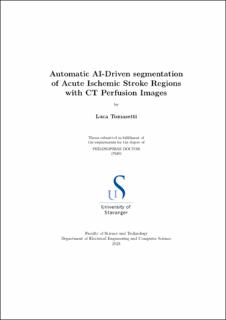| dc.contributor.advisor | Khanmohammadi, Mahdieh | |
| dc.contributor.advisor | Engan, Kjersti | |
| dc.contributor.advisor | Kurz, Kathinka Dæhli | |
| dc.contributor.author | Tomasetti, Luca | |
| dc.date.accessioned | 2023-12-01T12:31:24Z | |
| dc.date.available | 2023-12-01T12:31:24Z | |
| dc.date.issued | 2023 | |
| dc.identifier.citation | Automatic AI-Driven segmentation of Acute Ischemic Stroke Regions with CT Perfusion Images by Luca Tomasetti, Stavanger : University of Stavanger, 2023 (PhD thesis UiS, no. 733) | en_US |
| dc.identifier.isbn | 978-82-8439-201-1 | |
| dc.identifier.issn | 1890-1387 | |
| dc.identifier.uri | https://hdl.handle.net/11250/3105606 | |
| dc.description | PhD thesis in Information technology | en_US |
| dc.description.abstract | This thesis investigates artificial intelligence (AI) methodologies to automatically delineate ischemic areas of brain Computed Tomography Perfusion (CTP) scans acquired at hospital admission in patients suspected of acute ischemic stroke (AIS). Stroke, a critical neurological disorder, has a substantial socio-economic impact and a tremendous effect on the quality of life of afflicted subjects. Time is essential for dealing with this neurological disorder: every minute millions of brain cells die during a cerebral stroke. Consequently, developing accurate and rapid automatic prediction techniques for identifying the location and size of ischemic regions, including tissue with an extremely high probability of infarction (core) and potentially recoverable tissue (penumbra), are of serious clinical interest.
CTP is a fast and widely used 4D imaging modality employed upon hospital admission for evaluating stroke severity and aiding in treatment planning. Automated segmentation methods for CTP need to be perform fast and within the golden hour for identifying tissue-at-risk and prepare treatments. Current methods primarily rely on clinically interpretable 3D parametric maps derived from these scans. Parametric maps are also generally adopted by neuroradiologists for assessing this neurological disorder. However, few segmentation analyses have investigated the usage of AI pipelines with 4D CTP as input. These segmentation methods only focus on segmenting already infarcted areas or core regions, neglecting the penumbra. Nonetheless, predicting penumbra areas can hold significant importance in treatment planning.
This thesis explores conventional supervised and semi-supervised AI approaches to segment both penumbra and core areas. Parametric maps and CTP scans have been adopted as input for Machine Learning (ML) and Deep Learning (DL) algorithms to determine the most suitable input data for the automatic segmentation task. Scans from subjects of differentages and severity groups have been leveraged for training the ML and DL models, thus simulating real-world scenarios. Exploiting 4D CTP scans as input provided promising segmentation results on this dataset, regardless of the severity group, but it produced over-segmentation on large ischemic areas. Few-shot learning approaches returned promising outcomes; however, the results are still distant from supervised architectures. The thesis demonstrated the feasibility of employing CTP studies as input modality for segmenting both ischemic regions (penumbra and core) at hospital admission. | en_US |
| dc.language.iso | eng | en_US |
| dc.publisher | University of Stavanger, Norway | en_US |
| dc.relation.ispartofseries | PhD thesis UiS; | |
| dc.relation.ispartofseries | ;733 | |
| dc.relation.haspart | Paper 1: Tomasetti, L., Høllesli, L. J., Engan, K. Kurz, K. D., Kurz, M.W. & Khanmohammadi, M. (2021) Machine learning algorithms versus thresholding to segment ischemic regions in patients with acute ischemic stroke. IEEE Journal of Biomedical and Health Informatics, 26(2). DOI: 10.1109/JBHI.2021.3097591 | en_US |
| dc.relation.haspart | Paper 2: Tomasetti, L., Khanmohammadi, M., Engan, K., Høllesli, L.J. & Kurz, K.D. (2022) Multi-input segmentation of damaged brain in acute ischemic stroke patients using slow fusion with skip connection. Proceedings of the Northern Lights Deep Learning Workshop (NLDL), 2022. DOI: https://doi.org/10.7557/18.6223 | en_US |
| dc.relation.haspart | Paper 3: Tomasetti, L., Engan, K., Khanmohammadi, M. & Kurz, K. D. (2020) CNN Based Segmentation of Infarcted Regions in Acute Cerebral Stroke Patients From Computed Tomography Perfusion Imaging. Proceedings of the 11th ACM International Conference on Bioinformatics, Computational Biology and Health Informatics, 2020. DOI: 10.1145/3388440.3412470. This paper is not included in the repository due to copyright restrictions. | en_US |
| dc.relation.haspart | Paper 4: Tomasetti, L., Engan, K., Høllesli, L. J., Kurz, K. D. & Khanmohammadi, M. (2023) CT Perfusion is All We Need: 4D CNN Segmentation of Penumbra and Core in Patients With Suspected Acute Ischemic Stroke. IEEE Access. DOI: 10.1109/ACCESS.2023.3336590 | en_US |
| dc.relation.haspart | Paper 5: Tomasetti, L., Hansen, S., Khanmohammadi, M., Engan, K., Høllesli, L.J., Kurz, K.D. & Kampffmeyer, M. (2023) DOI: 10.1109/ISBI53787.2023.10230655. This paper is not included in the repository due to copyright restrictions. | en_US |
| dc.rights | Copyright the author | |
| dc.rights | Navngivelse 4.0 Internasjonal | * |
| dc.rights.uri | http://creativecommons.org/licenses/by/4.0/deed.no | * |
| dc.subject | AI | en_US |
| dc.subject | KI | en_US |
| dc.subject | kunstig intelligens | en_US |
| dc.subject | hjerneslag | en_US |
| dc.subject | CT-perfusjon | en_US |
| dc.title | Automatic AI-Driven segmentation of Acute Ischemic Stroke Regions with CT Perfusion Images | en_US |
| dc.type | Doctoral thesis | en_US |
| dc.rights.holder | © 2023 Luca Tomasetti | en_US |
| dc.subject.nsi | VDP::Mathematics and natural science: 400::Information and communication science: 420 | en_US |
| dc.subject.nsi | VDP::Teknologi: 500::Medisinsk teknologi: 620 | en_US |

